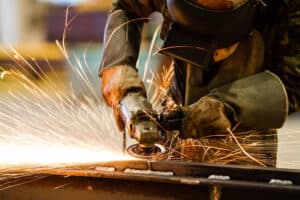
The success of any safety program relies on the emphasis safety is given within the company. A company culture of safety that originates with the senior management of the company, with the safety culture being promoted all the way down through the ranks of the company, will have a major impact on the safety record of a factory. (WCxKit)
Click Link to Access Free PDF Download
“4-Step Sequence For Effective Employee Screening, Hiring, & Placement”
14 Manufacturing Safety Guidelines
The safety guidelines for factories are similar to the safety guidelines in many other industries. Key factory safety guidelines include:
- All employees will wear all required safety gear, safety glasses, and safety clothing for their job/position while at their workstation.
- All employees working around moving machinery are prohibited from wearing loose clothing or loose jewelry.
- All employees working around moving machinery must have long hair tied back where it can not fall forward or be caught in the machinery.
- All tools will be in use or will be stored at their proper location at all times, no tools are to be left in any location where they are not being used or being stored.
- All equipment, tools and machinery are to be kept clean and in full working condition, with any defects being immediately reported to maintenance.
- The instruction manuals for all machinery must be readily available for review.
- All equipment and machinery is to be shut down when not in use.
- All presses and machinery will require two hand operation to keep fingers and hands away from moving part.
- All machinery is to have the manufacturer’s installed safety guards.
- No machinery is to be modified by any employee who is not specifically trained in the technical aspects of the machinery.
- All work areas are to be kept properly lit when anyone is working.
- All work areas are to be kept properly ventilated.
- All areas of the factory are be kept clean and organized.
- Anyone working in the factory under the influence of drugs or alcohol will be immediately terminated.
The safety officer for the factory should require every job to have a job hazards analysis with each employee performing that job being trained in recognizing the hazards to which they can be exposed and being trained on how they can safely eliminate or reduce those hazards. Each job should have a safety checklist with the employee being able to obtain a 100% grade on test questions about the requirements of their safety checklist.
Any Identified Hazards Should be Immediately Addressed and Corrected
All employees conducting work that requires specific OSHA training must be required to complete the OSHA training before they can start work in the factory.
The factory safety officer should perform frequent factory inspections to identify any hazards the employees might have missed. Any identified hazards should be immediately addressed and corrected. The safety officer should also hold regular scheduled safety training classes as well as requiring safety classes for all new hires before they can do any work in the factory.
Fire drills and other emergency evacuation drills should be conducted to ensure all employees know how to quickly and safely leave the building. As a part of all emergency drills, the employees need to know whether to shut down their machinery or to leave it running when they evacuate the building. As a part of the fire and emergency evacuation drills, all employees need to know where the fire extinguishers, fire hoses and other emergency equipment is located, and how to use the equipment in an emergency. (WCxKit)
Strong Safety Program Will Significantly Reduce Injuries and Costs
The establishment of a strong safety program within the employer’s factory will result in a significant reduction in the number of workers compensation claims and their resulting cost. If you need any assistance in establishing your factory’s safety program, our website has extensive information about building a safety program.

Do not use this information without independent verification. All state laws vary. You should consult with your insurance broker or agent about workers comp issues.
©2011 Amaxx Risk Solutions, Inc. All rights reserved under International Copyright Law. If you would like permission to reprint this material, contact Info@ReduceYourWorkersComp.com.
















Very nice and descriptive blog. All 14 steps are helpful in manufacturing facility safety.
Good Manufacturing Safety Guidelines for an industry
Very important points on safety procedures. Apart from wearing safety equipment there is one more important thing and that is factory safety signs which gives information and warning for the safety of that place and people.
That is really good information …… thanks a lot .. its really help full for me ….
Short, simple, to the point, applicable from day 1
Thank you for your experience speak
Nice!!
how to download or print this page
As a beginner in safety field , i am sure this article will help me a lot . Thank you ☺
I’m comleted my safety engg I’m fresher boy Im searching job in garments or chemical factory
Really did great Job
Thanks Charlott, I appreciate the feedback. We all still have a lot to learn!
I just come across with your incredible blog site trying to find something, but I didn’t expect that I’ll be taking a look at great deals of excellent short articles from different subjects. I have actually likewise noticed how your blog template was designed and I can state you truly did a fantastic job getting the design or making it. I know how difficult it is to create a blog design template specifically the logo design and the color scheme. I have actually been blogging for fairly some time now and I still learning a lot from co bloggers like you. Have a great day and more power to your blog.